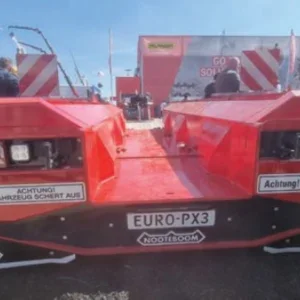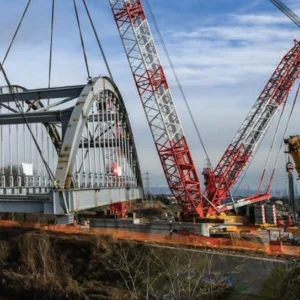The 250USt (227t) TCC- 2500 telescopic crawler will open up new jobsite opportunities, the company says.
The machine can lift, reach and travel like a large fixed boom lattice crawler, while also having the ability to retract the boom and reduce its overall profile as jobsite conditions require.
“The long-term plan for our telecrawler line-up brought us to this point. We identified early on that our customers needed a telecrawler with higher capacities and greater reach,” says product manager, lattice and telescopic crawler cranes, Scott Knight. Production units will be ready for shipment in March.
The TCC-2500 features a Tier 4 Final Cummins QSL 9 diesel engine. Its seven-section 43.7-223ft (13.8- 67.9m) pin and latch boom is the longest in class and offers eight simple boom extend modes.
It has a three-piece offsettable fly measuring 12ft, 40ft and 67ft and can also be equipped with two 25ft boom extensions for an overall tip height of 346ft.
These attachments with optional hydraulic luffing allow for ‘up-andover’ capacity like luffing lattice crawlers.
Another key feature of the TCC- 2500 is an extra-wide winch design that can handle its maximum permissible line pull through the fourth layer – front and rear winches are matching. The rear auxiliary winch can be removed for transport weight reduction and a power pinning system mitigates work-at-height exposure.
In the cab there is a 10in full colour display that incorporates both RCL and engine data. It has a resistive touch screen that can be used with gloves and be seen in direct sunlight. Operator jobsite view is enhanced with four cameras: rear view, blind-side swing-side, and two individual winch-view cameras.
Track gauge for the TCC-2500 is rock solid at 20ft 4in. The lower car body is a hook and pin system which makes assembly quick and easy.
The TCC-2500 can self-assemble side frames with standard equipped car body jacks and wireless remote control for hydraulic pinning and jack operation. Customers will use new two-bar grouser track shoes that provide excellent traction with standard Nylatron pad inserts to protect sensitive ground surfaces.
“Our goal from the beginning was to supply a simplified design, quick and easy to assemble, that is operator-friendly,” says Knight.
The TCC-2500 can also move quickly and easily on and off the jobsite. The main transport load weighs under 106,000lb.
Once the crane is off the trailer, car body jacks can be deployed via remote control.
Link-Belt’s proven TCC counterweight system attaches 154,000lb of upper counterweight. It is a nine-piece modular design and transports on seven overflow loads, all 44,000lb or less.
At ConExpo Link-Belt will also debut the new 130USt 228 HSL. This crane builds on the success of the Link-Belt HYLAB lattice boom crawler line-up and takes another step forward with transport and attachment versatility.
The 228 HSL can move under 120,000lb as an assembled machine, with tracks on. Removing the side frames achieves a transport weight of under 80,000lb.
It is powered by a quiet 270hp (201kW) Cummins QSB 6.7L Tier 4 final diesel engine. An “auto-idle” allows the operator to shut down the engine for fuel economy during extended idle periods; engine RPMs resume immediately when the throttle is activated.
The Cummins power plant couples to a direct drive gearbox powering the Kawasaki main pump package.
Matching main and auxiliary power-up and power-down winches, equipped with a selectable free fall system, come as standard.
The main hoist drums are grooved for 26mm wire rope. The winches have a maximum line pull of 43,198lb and feature Link-Belt’s wet brake design, giving the operator superior control of the load on hook during freefall operation.
Link-Belt’s Eco Winch is an additional fuel-saving feature. It allows for maximum line speeds when hoisting light loads at idle engine speeds, resulting in greater energy efficiency, lower operating cost, lower engine RPMs under load, and fewer emissions.
In the cab the operator has high resolution winch-view, rear-view, and blind-side and swing-view cameras.
An audiovisual travel alarm system alerts crew members on the ground. The intuitive RCL monitoring system provides the operator with all lift information and allows the operator to set swing and other control parameters, creating visual walls with audio, visual alarms and function kick out.
Like many Link-Belt HYLABs, the 228 HSL offers maximum boom lengths with two different styles of boom: tubular boom, up to 235ft and angle boom up to 155ft. The open throat top section features quick reeve capabilities and will incorporate a fold-down three-sheave- idler assembly.
“The newly designed idler will allow three working lines to run independently up and down the boom, and make for more gradual radius rope travel over the head sheaves. The idler can be easily stored for transport by rotating down and riding inside the boom,” said Knight.
A fixed jib, common to the 218 HSL, with lengths of 30ft to 75ft in 15ft sections is available.
Standard features on the car body include hydraulically extendable side frames, hydraulic car body jacks, swing out axle extenders, and centralised grease points. Side frames feature completely sealed undercarriage components, hydraulic track tensioning system and self-cleaning full contact track shoes.
The 14ft 6in track gauge in the extended position provides a sturdy base for operations. Two 13,250lb hook and pin style car body counterweights fit neatly between retracted side frames.
To accommodate varying transport regulations in North America, the 228 HSL is equipped with car body jacks and quick disconnects for lower hyraulics for quick and easy installation and removal of side frames when needed. Once on a transport trailer, the 228 HSL has a retracted track width of 11ft 11in. A nine-piece modular counterweight configuration makes it easy to move the 228 HSL and, depending on geography, it can be transported with full counterweight in four or five loads. Link-Belt has also introduced the new 250USt 298 Series 2 lattice crawler crane, building on the success of its predecessor, the 298 HSL.
The new boom design of the 298 Series 2 allows the working combination boom tip section to remain in place when transitioning from conventional mode to luffer, with a maximum combination of 180ft of luffing boom and 195ft of luffing jib.
To provide quick conversion from conventional lifting to a luffing configuration, assembly has been simplified with semi-bore weldments for pin locations; point of use storage for all components; and stop bolts for quick pin alignment.
Assembly is also aided by a new luffing jib transport package with lifting lugs. The rear post scissors into place by means of alignment links. The transport package also comes assembled with nylon rope reeving to assist with initial luffing jib wire rope hoist reeving. Once the rear post is in working position, all luffing jib pendant connections are made and the luffer is ready to be raised.
All assembly is done from the ground, with no work at height exposure. The 298 Series 2 also features a new base section and 12in wide boom walkway. Bar pendants with storage brackets replace dual wire rope pendants. A newly designed retractable auxiliary lifting sheave has a 25USt capacity and offers two parts of line.
Conventional boom length remains the same as the 298 HSL at 60-290ft. The maximum tip height of boom and jib is 342ft 3.2in. The 298 Series 2 features a Cummins QSL 9 Tier 4 engine and, like the 228 HSL, includes the Eco Winch.
At ConExpo Link-Belt will also showcase the latest evolution of its crane operating system, Link-Belt Pulse 2.0.
The system provides a simple interface for crane operators, with a larger display and programmable feature that allow operators to customise their display.
The 10in (25.4cm) display is 47% larger than the original Pulse screen and is built for harsh environments.
The screen, pivot-mounted for optimal viewing, can be used with gloves and seen in direct sunlight. It also features larger buttons and interative indicator lights displayed on the margins.
Start-up is aided by faster hardware/software response and the need for fewer operator inputs.
Electronic level/list display, as well as ground bearing calculator are integrated, depending on the model. In response to operator input, the new system also allows the live display data to be maintained for an extended period once the engine has been shut off.
Pulse 2.0 also enables the crane’s software to be serviced and updated remotely. The system includes a Wi-Fi hub and uses the unit’s serial number to check for updates and download to the appropriate controller.






